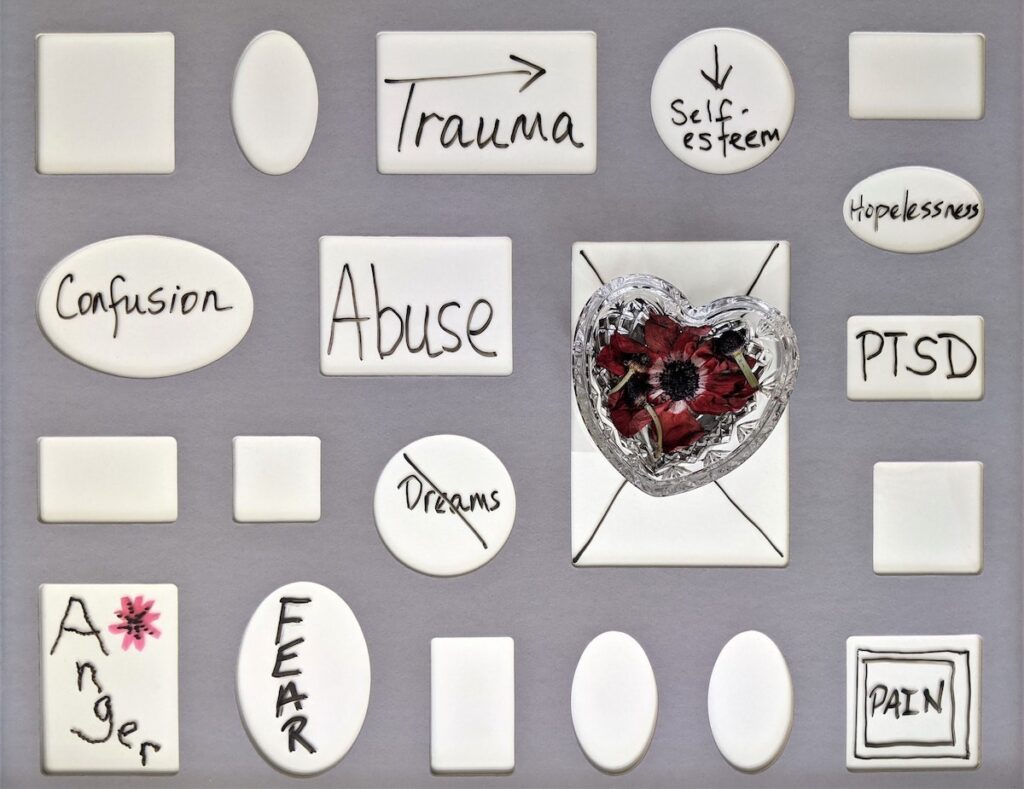
Self-harm, an umbrella term that encompasses ‘intentional self-poisoning or self-injury, irrespective of suicidal intent’ (Hawton et al., 2012), is a considerable clinical and public health challenge. Although people of all demographics self-harm, it is more common among young people, with prevalence estimates suggesting around 17% of young people have self-harmed in their lifetime (Gillies et al., 2018).
While unique to the individual, many people self-harm to manage distress or emotional dysregulation (Madge et al., 2008; Rodham et al., 2004). Some evidence suggests psychosocial interventions, such as Dialectical Behavioural Therapy (DBT) and Cognitive Behavioural Therapy (CBT), can help to address the underlying emotion dysregulation and repetition of self-harm (Witt et al., 2021). However, evidence is varied and there are often long wait times for these treatments in the UK (Cooper, 2018). Is harm minimisation, a more practical and imminent technique, key to consider?
Harm minimisation aims to reduce the negative impacts of a behaviour without stopping it completely (Hawk et al., 2017). In this context, the aim is to reduce “the harm from self-harm”, by helping people to practise it safely (e.g., providing knowledge of anatomy and wound care), to distraction techniques, such as pinging elastic bands on the wrists (Pengelly et al., 2008), among others. It is a contentious issue and under-researched: there are no randomised controlled trials or cohort studies about its effectiveness for self-harm management, only general NICE guidelines (NICE, 2014).
Qualitatively, two key papers present mixed views about the acceptability of harm minimisation for self-harm to people that practice it. However, this research is only focussed on narrow techniques and primarily adolescents (Wadman et al., 2020, Mental Elf Blog; Davies et al., 2020; Mental Elf Blog). Limited research and conflicting views call for a mixed method approach to better understand the technique.
In this mixed-method study, Charlotte Cliffe and colleagues including Sarah Rowe (2021) aimed to determine the prevalence, sociodemographic and clinical characteristics of those who self-harm and practice harm minimisation within a London mental health trust, as well as to define the methods used and their acceptability to patients.

Harm minimisation for self-harm – a technique that can reduce damage from the behaviour without stopping it completely, is both contentious and under-researched.
Methods
In this mixed-methods study, the authors analysed the electronic health care records of people who both self-harm and practice harm minimisation within the South London and Maudsley (SLaM) NHS trust.
Initially, the authors conducted a pilot study within the Camden and Islington Mental Health Trust to develop a suitable search strategy for the electronic health care records via the Clinical Records Interactive Search (CRIS) data extraction system.
Primary study
Using CRIS, researchers obtained all electronic health care records for patients at SLaM. Records for the harm minimisation group included people of any age, with a history of self-harm, who had documented harm minimisation as a strategy to manage self-harm within SLaM from 2008-2019. They defined self-harm using section two of the Health of the Nation Outcome Scale (HoNOS) routine assessment tool (using a cut-off≥ 2). The control group included people who reported self-harm at least once during the same period, but were not identified as using harm minimisation techniques.
From both groups they extracted sociodemographic data (e.g., age, gender, ethnicity, marital status), and whether a person had self-harmed with suicidal intent and hospital admissions. If a person had multiple records documenting harm minimisation, they extracted demographics from the first record, however, all records were included for the content analysis.
Content analysis
The authors analysed the free-text entries from extracted records to determine both the method of harm minimisation and whether it was helpful or unhelpful. A primary researcher coded data to establish a classification system, using an iterative approach. A second researcher independently coded 5% of included records to confirm the presence or absence of harm minimisation practice. They practiced reflexivity by conducting team meetings to discuss and review the emergent coding framework.
Results
Searching SLaM electronic health care records identified 22,736 people who met the criteria for self-harm (>2 on the HONOS scoring system). 693 people (3%) reported self-harm and harm minimisation.
Sociodemographic characteristics
- The majority of people in the harm minimisation group were female (546, 79%) and between the ages of 16-25 years old
- Most people were of White ethnicity (506, 73%) and single (468, 67.5%)
- Compared with the control group, the harm minimisation group were significantly younger (mean age 24.4 vs 36.0) and were more likely to be female. There was no significant group difference in ethnicity, employment, or socioeconomic status.
Clinical characteristics
- Compared with the control group, the harm minimisation group was more likely to have had more previous hospital admissions, have a diagnosed affective, anxiety, or eating disorder
- They were less likely to have a psychotic disorder and to have self-harmed with suicidal intent.
Content analysis: descriptions
Coding of the free-text records resulted in four categories of harm minimisation. The categories present numbers and %’s relating to the total of all mentions of harm minimisation (denominator of 822). 193 (23.5%) of records could not be classified based on limited information.
- Substitution: self-harm that replaces or replicates pain e.g., elastic bands on the wrists or cold water. 427 mentions (51.9%).
- Simulation: refers to the process of simulating harm e.g., by using a red pen on the skin. 70 mentions (8.5%).
- Defer and avoid: describes the delay of self-harm, but it also included methods to avoid the risk of physical damage, such as providing knowledge on anatomy. 58 mentions (7.10%).
- Damage limitation: wound care to minimise infection risk. 74 mentions (9.0%).
Content analysis: perceived usefulness
- Of those reporting harm minimisation, 638 (92.1%) were coded as finding it helpful.
- Those that were coded as finding it unhelpful, 55 (7.94%) suggested it was ‘ineffective’ or that it ‘escalated into self-harm’.

3% of people within SLaM are documented as having self-harmed and having used a harm minimisation strategy. However, 92% of this group described it as helpful.
Conclusions
Within SLaM, of people that self-harmed, 3% are documented as having used a harm minimisation strategy. Of that small proportion, the majority (92%) of people found it helpful.
Overall, the group that both self-harmed and used minimisation techniques were more likely to be younger and aged between 16-25 years old. Authors note that this might be “the age at which patients may be most likely to be active online with exposure to educational materials shared online about harm minimisation”.

Those in the self-harm and harm minimisation group were more likely to be younger and aged between 16-25 years. It’s possible that this is the age patients are most likely to be active online with exposure to materials about harm minimisation.
Strengths and limitations
This is the first study to examine harm minimisation for self-harm using routine secondary mental health care data from a large and highly diverse mental health trust (SLaM).
A major strength of the study is the carefully piloted search strategy for the electronic health care records. The search was sensitive enough to capture the correct records but not too broad that it pulled through irrelevant ones. However, the authors note the challenge with the search term ‘harm reduction’, a phrase associated with addiction services, resulting in volumes of data.
A further strength includes the collaborative and iterative approach to the qualitative component. 5% of included records were independently coded by a second author, and the team practiced reflexivity, involving members with and without training in harm minimisation, to reduce bias and personal views influencing the coding.
However, there are some limitations:
It was only possible to code harm minimisation strategies where this was clearly documented in records. As a non-clinician, it is not clear if this is something that is routinely asked about in secondary mental health care, despite it being part of NICE guidelines. Authors mention this in their limitations section and suggest clinicians may be “reluctant to use harm minimisation for self-harm because of concerns about safety”, and previous research finds there can be strong and opposing views for staff on mental health wards about harm minimisation due to ethical and legal concerns (James et al., 2017). Similarly, it is possible patients do not disclose their methods, perhaps due to stigma.
A small number of records reported that harm minimisation was not helpful. Quotes presented in the paper for those that found it unhelpful relate to the substitution technique: it would be interesting to know if this was the main technique reported as unhelpful for all of those records.
A further limitation that authors note is that:
In cases where harm minimisation was implemented, records were frequently missing any details about the method being used, and some could not be classified based on the limited information.
Lastly, despite the diversity of SLaM data, this data is only representative of one part of the UK. Findings may not generalise to elsewhere in the UK, or to other countries.

This is the first study to analyse routine secondary mental health care data to investigate the use of harm minimisation for self-harm. However, electronic health care records were frequently missing key data on the details of the method, and some could not be classified based on the limited information.
Implications for practice
Harm-minimisation, a technique that aims to reduce damage from a behaviour without stopping it completely, could be a helpful strategy for managing self-harm. Within SLaM, although a small number of people are documented as using the technique for self-harm, 92% of this group found it helpful. However, there is some caution: those who found it unhelpful suggested it was “ineffective” and with the potential to “escalate self-harm”.
This is a timely study that gives insight into the demographics of people who use harm minimisation for self-harm within a large mental health trust in south London. However, harm minimisation in this context remains a complex issue with ethical implications. As a fellow Elf, Rachel Rowan Olive, powerfully comments in a previous blog:
in a way, all my self-harm is harm reduction: in a particular set of circumstances with the particular thoughts in my head, I am always doing the least harmful thing I can.
The authors highlight that future research needs “to explore the acceptability of different-harm minimisation techniques among a range of patients, carers, and practitioners”. I agree. I think it is key to understand which techniques are most helpful and to whom.
Lastly, although electronic health care records are rich with information, more thorough recording of harm minimisation needs to be implemented. Research conducted on records are only as good as the records themselves. Studies designed to specifically answer harm minimisation research questions are needed, including clinical trials to understand how effective this technique is for reducing self-harm.
To me, the key takeaways are:
- harm minimisation for self-harm has the potential to be helpful;
- recording of harm minimisation within mental health trusts needs to be improved;
- further research to ascertain which minimisation techniques are helpful and for whom, are key.

Harm minimisation for self-harm remains a complex issue. Further research to ascertain which techniques are helpful, in what settings, and for who, is key.
Statement of interests
No conflicts of interest.
Links
Primary paper
Cliffe, C., Pitman, A., Sedgwick, R., Pritchard, M., Dutta, R., & Rowe, S. (2021). Harm minimisation for the management of self-harm: a mixed-methods analysis of electronic health records in secondary mental healthcare. BJPsych open, 7(4). {abstract}
Other references
Cooper K. The Devastating Cost of Treatment Delays. BMA News & Opinion, 2018. {link}
Davies J, Pitman A, Bamber V, Billings J, Rowe S. Young peoples’ perspectives on the role of harm reduction techniques in the management of their self-harm: a qualitative study. Arch Suicide Res 2020; https//doi.org/10.1080/13811118.2020.1823916
Gillies D, Christou MA, Dixon AC, Featherston OJ, Rapti I, Garcia-Anguita A, et al. Prevalence and Characteristics of Self-Harm in Adolescents: Meta-Analyses of Community-Based Studies 1990–2015. Journal of the American Academy of Child & Adolescent Psychiatry. 2018;57:733–41. {abstract}
Hawk, M., Coulter, R. W., Egan, J. E., Fisk, S., Friedman, M. R., Tula, M., & Kinsky, S. (2017). Harm reduction principles for healthcare settings. Harm reduction journal, 14(1), 1-9. {abstract}
Hawton, Saunders K E, O’Connor, R. Self-harm and suicide in adolescents. The Lancet. 2012;379:2373–82. {abstract}
James, K., Samuels, I., Moran, P., & Stewart, D. (2017). Harm reduction as a strategy for supporting people who self-harm on mental health wards: the views and experiences of practitioners. Journal of affective disorders, 214, 67-73. {abstract}
Madge, N., Hewitt, A., Hawton, K., Wilde, E. J. D., Corcoran, P., Fekete, S., … & Ystgaard, M. (2008). Deliberate self‐harm within an international community sample of young people: comparative findings from the Child & Adolescent Self‐harm in Europe (CASE) Study. Journal of child Psychology and Psychiatry, 49(6), 667-677.
National Institute for Health and Care Excellence. Self-Harm in Over 8s: Long-Term Management 2011. Harm Reduction section 1.4.10. NICE, 2011 (https://www.nice.org.uk/guidance/CG133/chapter/1-Guidance#longer-term-treament-and-management-of-self-harm)
Pengelly, N., Ford, B., Blenkiron, P., & Reilly, S. (2008). Harm minimisation after repeated self-harm: Development of a trust handbook. Psychiatric Bulletin, 32(2), 60–63. doi:10.1192/pfb.bp.106.012070
Rodham, K., Hawton, K., & Evans, E. (2004). Reasons for deliberate self-harm: Comparison of self-poisoners and self-cutters in a community sample of adolescents. Journal of the American Academy of Child & Adolescent Psychiatry, 43(1), 80-87. {abstract}
Wadman, R., Nielsen, E., O’Raw, L., Brown, K., Williams, A. J., Sayal, K., & Townsend, E. (2020). “These Things Don’t Work.” Young People’s Views on Harm Minimization Strategies as a Proxy for Self-Harm: A Mixed Methods Approach. Archives of suicide research, 1-18, doi: 10.1080/13811118.2019.1624669.
Witt, K. G., Hetrick, S. E., Rajaram, G., Hazell, P., Salisbury, T. L. T., Townsend, E., & Hawton, K. (2021). Psychosocial interventions for self‐harm in adults. Cochrane database of systematic reviews, (4). {abstract}
Photo credits
- Photo by Pier Monzon on Unsplash
- Photo by Susan Wilkinson on Unsplash
- Photo by Katie Gerrard on Unsplash
